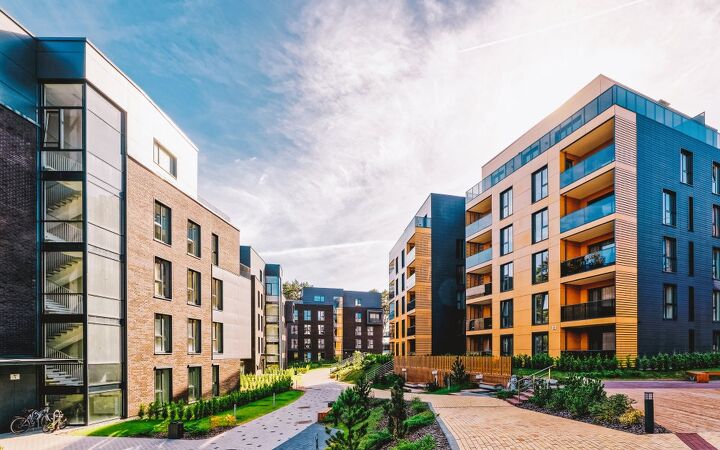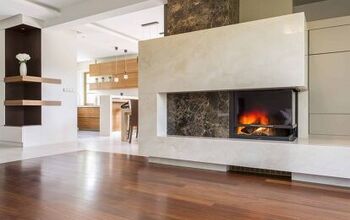20 Different Types of Apartments

Moving into an apartment can be an exciting time if it is your first apartment. It is a big step into the world. However, it can also be overwhelming since it requires a lot of expense and planning. Doing your research means you will know what you are looking for, but many different types of apartments can be accommodating. Some are affordable, and some come with an expense.
When apartment shopping, keep in mind that there is a wide variety to choose from. You can choose a one-bedroom, railroad, or studio apartment. Or, if you’re looking to live a life of luxury, then you can shop the high-rise and penthouse apartments. Of course, there are many more in between.
It is one thing to consider affordability within the location you want, let alone the apartment’s style and layout. Apartments come in all different shapes, sizes, and amenities. So, the type of apartment you want must be a primary factor. This way you can decide on what you can afford.
How To Choose An Apartment
There are a lot of details when considering an apartment. There are different components that may make a final decision harder to decide. One apartment might be more appealing than the other that is more affordable. Here are some thoughts to help when choosing an apartment:
Prioritize
Know what is important to you and create a list of priorities in order of importance. This list is something to refer to during the searching process. Some things to consider are affordability, accessibility, and layout. This should help thin out the search list.
Search
The perfect apartment is not going to show up; you have to look for it. During the searching process, it is a good idea to keep notes. Dedicate a notebook to your apartment searching where you can title each page per property and list the information to that property. It would even be helpful to add some photos to the pages to refer back to. You can also utilize this to write out any questions you may have for the landlord before seeing the property.
Ask For Opinions
If you plan on moving in with a roommate, this task will be easier, as they will be with you throughout the process. However, if you are flying solo, bringing a friend or family member along your search is always helpful. If no one is available to go with you, then plan a time to go over your notes with someone. Another perspective for this life-changing decision is always a good idea.
20 Different Types Of Apartments
Below is a list that we compiled consisting of 20 different types of apartments.
1. Loft Apartment
Loft apartments are former industrial buildings that were renovated to accommodate residential living. They are larger than the traditional apartments and have an open space, without any internal walls defining specific rooms for dining or living. Of course, there is a private bathroom. They are designed with high ceilings, large and high windows, and usually have exposed brick or pipes.
Of course, with each apartment type comes pros and cons. The benefit of living in a loft apartment is that they typically cost less to rent. Think of them as a glorified studio apartment. You have plenty of space, and sometimes this includes two stories, and the bedroom is typically upstairs.
The drawback, however, is that the entire apartment lacks privacy aside from a bathroom. Even then, sometimes they do not include doors on the bathroom, so you either need to be very comfortable with who you’re sharing this space with or live here alone.
2. Studio Apartment
A studio apartment is a small area that has an open floor plan within the open space in the kitchen, dining room, and bedroom. There is a private bathroom and maybe a closet. This is the ultimate bachelor pad, or perfect for someone who loves the minimalist lifestyle as there aren’t many places to put things in a studio apartment.
Like a loft, the rent is usually significantly less than that of a one or two-bedroom apartment. Not to mention, the studio apartments seem to be widely available. However, the disadvantage is that you don’t have much space or privacy. This is not an excellent apartment to have a roommate living with you in as there’s no way to separate the area. Everything is shared.
Related Guide: Why Are Studio Apartments So Expensive?
3. Micro Apartment
Micro apartments are similar to Studio apartments but much smaller. They are popular within cities that have larger populations. The open floor plan space is simply a bedroom, bathroom and has a kitchenette. Some buildings with micro-apartments may have communal kitchens and bathrooms.
These apartments are perfect for college students who have a tight budget or anyone who doesn’t spend much time at home. The rent for this type of apartment is significantly less than a studio. However, the space is so tiny that you might not be able to fit two people in the room comfortably.
4. Duplex Apartment
The term duplex has multiple meanings to residential living. However, for apartments, a duplex apartment is a two-floor single living apartment. The first floor is the living area, with a kitchen, dining room, and bathroom. The upstairs is connected by a staircase where usually the bedroom is found.
A duplex is excellent, and it has that ‘house’ feels to it without the cost of living in an actual house. And if you end up with neighbors you get along with; then there are virtually no issues. However, the yard space may be shared. But, if you and your neighbors get along, then this shouldn’t be an issue.
The most significant disadvantage of a duplex is having to share a wall with your neighbors. If they’re loud, then that’s something you’ll have to deal with. This is a case where you have to get to know your neighbors before moving in so that you can gauge whether this is a situation that you want to be in or not.
5. Triplex Apartment
A triplex apartment is very similar to a duplex apartment; however, the only difference is the triplex has an extra floor. All three floors are connected by a staircase and share the main floor as kitchen, dining, and bathroom. The most popular staircase used in a triplex is the spiral staircase to have space.
This could be a great arrangement, again, if you get along with your neighbors. In this situation, that’s almost vital as you’re sharing walls with your neighbors. The biggest con of a triplex apartment is that while you have your own space, you’re still in close quarters to others and may be forced to socialize even when you’re not in the mood.
6. High/Mid/Low-Rise Apartments
High-Rises are a typical building found in a lot of cities. Although there may be some confusion as to if the building that has been called a high-rise your whole life is a high-rise. There are three different types of these community apartments: low-rise, mid-rise, and high-rise. Low-rise buildings have one to four floors, high-rises have twelve or more floors, and mid-rises are somewhere in between. Of course, the more floors they have, the more elevator access is available too.
The apartment you choose between the three of these depends on your preferences. Some people prefer a ground-level apartment, while some love to be high up in the air. If you have a fear of heights, you may opt for a low-rise apartment as opposed to a high rise. Or, if you’re in an earthquake-prone region, then a low-rise apartment could be the better choice for you.
The downfall of the high rise, in particular, is that they’re in high demand and can end up costing you a fortune to rent. Most high-rise apartments are $3,000 or more just for a one-bedroom apartment. On the other hand, low-rise apartments can have a negative side, especially if you’re in an area with a high crime rate. A ground-level apartment gives thieves easy access to your home.
7. Garden Apartment
These types of apartments have direct access to private outdoor space. These outdoor spaces do not mean they are an actual garden. It is referring to the fact the apartment is surrounded by greenery. This can be lawns, patios, or wooded areas. The only downside to this apartment-style is it can sometimes be partially underground, which can flood or pest issues.
Another benefit of a garden apartment is that it’s the perfect style of the apartment to host a gathering in since you do have the yard and or patio space. You don’t have to cram everyone out onto a balcony as there is plenty of patio space. However, a garden apartment can cost up to $500 more than 2nd level apartment.
8. Basement Apartment
A basement apartment is an apartment located below the street level. This can be a basement of an apartment complex or a resident below a business. The most common is renovated basements by homeowners for supplemental income. These apartments are very affordable, but they could come with some disadvantages, such as mold exposure.
Basement apartments usually run between $300 to $700 per month, depending on the amenities that come with it. However, be aware that you will be living in someone else’s house. Also, there usually isn’t much natural light as you’ll be living underground. But, because of the affordability factor, some people don’t mind.
9. Alcove Apartment
An alcove apartment is a type of studio apartment but a little bit bigger. It is constructed in an “L” shape to create an alcove. This creates a space for more privacy that some people use for their bedroom. It also gives the impression that there is more space in the apartment than there is.
The plus side of an alcove apartment is that you can comfortably share this space with a roommate while keeping your privacy. One person can have the extra space as a bedroom. At the same time, another can put up a privacy divider in the corner of the living room to make their own ‘bedroom.’ However, it’s hardly as big as a one bedroom apartment, so if you’re worried about space, then an alcove may not be the best fit for you.
10. Penthouse Apartments
The Penthouse Suite is an apartment on the highest floor of the apartment complex. It is considered a small house built on top of the building. It is usually equipped with luxury amenities. Penthouses are enormous and typically have a beautiful view of the city. Of course, these features mean they are one of the most expensive styles of apartments.
If you’re thinking of renting out a penthouse, the advantages are endless. You have your own private space, a great view, plenty of space, and you get to lavish in luxury. However, penthouses can cost anywhere from $4,000 a month to over $10,000 a month, depending on the penthouse and city you are staying in.
11. One Bedroom Apartments
This is your typical traditional apartment. It has designated rooms for the kitchen, living, and dining. There are multiple descriptions for this apartment-style as the number of bedrooms is added to the layout. The significant difference between this apartment and a studio or a loft apartment is the apartment’s overall size. There is a designated bedroom of 70 to 80 square feet with closet space.
With a one-bedroom apartment, you are guaranteed your own private space. This is great for couples to be able to separate and do their own thing throughout the day. Not to mention, there is plenty of space to put your belongings. However, the downside to a one bedroom is that it’s not quite large enough for a family that has multiple children.
12. Junior One Bedroom Apartments
A junior one-bedroom apartment is not to be confused with an alcove apartment. The bedroom that is found in this apartment is almost considered a ¾ bedroom. It is so much smaller than the space located in the alcove apartment that it is not legally called a bedroom in some states. You can think of it almost as a walk-in closet.
The junior one-bedroom apartment is great for a couple looking to lease their first apartment before starting their family, or perhaps a single adult who is focusing on finishing up college or concentrating on work. They’re spacious and fully functional. However, the space is still limited. It’s less space than a one-bedroom apartment and only about $50 cheaper.
13. Convertible or Flexible Apartments
This apartment-style follows the same layout as a studio apartment; however, there is extra space to accommodate the closing part of the area to convert it into a bedroom. This apartment style is excellent because it adds flexibility to the tenants’ lifestyle, but some landlords may not want the extra construction because there is room to do so.
The convertible apartment is excellent for the individual or couple who often need more space for other things such as working out, working, or hosting a party. The plus side with this is that you can quite literally tuck your bed away and turn your apartment into a gym. Or, you can redecorate and pull out specific furniture for a dinner party.
The downside to this type of apartment is that it takes a lot of prep time. You’re constantly changing your space which can get old fast. This also increases the risk of injury as you may frequently need to move a large piece of furniture.
14. Corporate Apartments
Corporate apartments are not what they seem. They are defined as “turn-key” apartments and are fully furnished. Their lease agreement is decided on a short-term basis. These types of apartments were adapted to accommodate corporate professionals that travel quite frequently. However, they can be used by anyone, and they can be most appealing to house hunters who have not found the right house yet.
When leasing a corporate apartment, you will usually find a designated workspace which is excellent for those that work from home. Additionally, it’s already furnished, so there’s no need to spend that extra $5,000 getting the things you need since you’ll already have them. However, the rent can be considerably high. And, since it’s already furnished, you probably won’t be able to do anything about the decor if you don’t like it.
15. Co-op Apartments
This type of apartment is more of an investment style of housing. This is where one would buy into the property the apartment building is on. By buying into it, the part-owner would have the right to live on the premises. They would also share in the financial responsibility of the property as well.
The co-op apartment is excellent for anyone looking to get into business, as you would be able to put this type of investment into your resume. Also, you’ll have a right to live on the premises, which means you’ll have free rent! However, the downside of this is people may be knocking on your door all hours of the day to ask for assistance once they find out who you are.
It’s vital that you set limitations and boundaries if you were to reside within the apartments. That way, you can separate your work life from your personal life.
16. Walk-up Apartments
A walk-up apartment is in a smaller building with multiple tenants. The only access to the apartments is by the staircases. These apartments are more affordable however may be less desirable since there is no elevator. The great thing about walk-up apartments is that they’re usually pretty affordable since you’re living on top of one another. However, there is no way to keep your distance from your neighbor, so you will need to figure out what’s most important to you before deciding whether a walk-up apartment fits your lifestyle.
17. In-Law Apartment
An in-law apartment is sometimes considered a secondary suite or an accessory dwelling unit. It is a smaller unit that is stand-alone. It is a room that is usually found on the same property as a single-family home but is a separate unit. Sometimes it may be attached to the house, but it always has its entrance.
The great thing about an in-law apartment is the privacy aspect. You usually have your entry, space, kitchen, bathroom, shower, and more. There is no space that’s ‘shared’ except maybe for the yard or driveway. Other than that, you run the ‘household’. However, the downside is that you typically live right next to your landlord. But some people don’t mind living next to their landlord when they’re paying less for the in-law apartment than they would a regular apartment.
18. Luxury Apartment
Luxury apartments are top-of-the-line apartments. They include every type of amenity you could think of. This could be valet parking, fitness centers, or even on-site movie theaters. They can be very expensive, but that is because they are well maintained. They are private and secure apartments and are fully furnished with exceptional features.
A luxury apartment has plenty of space, so it wouldn’t matter how many children you have or how many roommates you would want to include on your lease. Some apartments have smart technology included, so you could tell Alexa when to shut your blinds, turn on your music, or even start the stove.
The downside to the luxury apartment is that usually there is no yard space. These dwellings typically sit in the center of a city, so you’re still going to deal with loud noise and traffic, no yard, and still have close neighbors.
19. Railroad Apartment
This apartment-style has a series of rooms positioned one after the other from the entryway to the back wall. They are connected by a single hallway, with each room having its doorway from the hallway. This is efficiently constructed to ensure privacy and functionality, especially when there is more than one person living in the apartment.
Even though the railroad apartment is considerably small, the layout is perfect for having a roommate or two. The rent is also relatively affordable, and you get to enjoy the vintage-esque apartment style. However, since these are a bit older, sometimes there can be issues with the plumbing or electricity. If so, call your landlord and get it taken care of as soon as possible.
20. Shotgun Apartment
A shotgun apartment is very similar to a railroad apartment; however, there is no hallway. This creates a straight floor plan and consists of three to four rooms. These rooms are your main rooms, such as kitchen, living room and bedroom. Pocket doors or windowed French doors usually separate them.
If you’re tired of the conventional apartment layout, then a shotgun apartment might be in store. You’ll have everything close by but still have separate areas. So it’s like a studio apartment and railroad apartment in one, but without a hallway. However, people pay a little bit more for the convenience of this type of apartment.
Things To Consider Before Renting An Apartment
Before you rent an apartment, there are several things that you should consider. This will help you choose the best option for your circumstances.
- Upfront Costs: Before you even get the lease to your new apartment, there are some expenses that you may not have thought about. These could be application fees, pet deposit, and security deposit, which is usually the first and last month’s rent, but may be additional.
- Long Term Costs: Rent is a long-term expense once you move into your apartment; however, it is not the only expense. Other expenses can be utilities or commonly purchased items. They could be electric, gas, clothes, cell phone, or groceries, to name a few.
- Location: The next component of apartment hunting is the location it will be in. It is crucial to map out where the apartment is located based on your work or favorite grocery store.
- Amenities: The priority list you created before you started your apartment search will help you the best with your decision. Your list should include things that are important to you that you cannot live without.
- Lease Terms: Before you sign anything, READ! Especially if this is your first time reviewing a legal document. Some of the legalities can be hard to understand, so this is the best time to be asking your future landlord any questions.

Heather is a passionate writer who loves anything DIY. Growing up, she learned everything from home repairs to design, and wants to share her tips with you. When she's not writing, she's usually hiking or searching for her next DIY project.
More by Heather Robbins















































